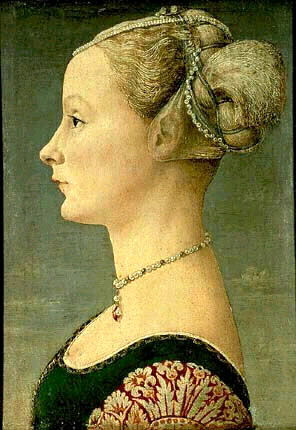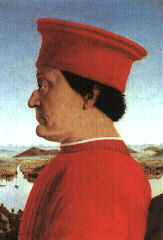Insights to Art
Pollaiuolo's Portrait of a Lady

Pollaiuolo, Portrait of a Lady - Poldi Pezzoli Museum, Milan

Piero Pollaiuolo (attr.) Portrait of a Lady (1470s; 46cm x 33cm)
The Painter(s)
It is difficult to know for certain which of the Pollaiuolo (or "del Pollaiolo") brothers painted this Portrait of a Lady (Ritratto di dama or Ritratto di gentildonna, in Italian). Antonio Pollaiuolo (1432-1498) was the more famous and more skilled, but this portrait is generally thought to be the masterpiece of his brother Piero (1441-1496). The portrait is one of the most outstanding in a series of female portraits painted by the Pollaiuolo brothers in the late fifteenth century, and which are now scattered throughout museums in Europe and America. The Pollaiuolo brothers were successful Florentine artists working in the second-half of the fifteenth century with a large workshop in the city. Like many other artists of the time, they were great students of anatomy and classical sculpture, and their figures are particularly realistic also for this reason.
An Uncluttered Background, a Fine Head
The lady of the portrait is shown against a light blue sky with a few clouds dotted here and there, a background that does nothing to detract from her fine features and finery. Thanks to a thin black outline around the head and neck, the figure seems to emerge from the uncluttered background. With shoulders and bust very slightly turned towards the spectator, an impression of dimension is given, helping to offset any excessive flatness. The use of light and shade on the lady's hair, pearls and skin is clear indication of the painter's skill in giving a sculptured effect, a technique the Florentine painters had learnt from their Flemish counterparts.
The Lady of the Portrait
The lady's gathered hair is covered with a fine, almost transparent net and decorated with a string of small pearls, details which reveal all the painter's skill. A second string of pearls set in gold decorates the top of her head and was a common accessory for wealthier Florentine women of the day. The exquisite necklace of white and black pearls has a pendant with a large ruby drop. Likewise, her dress is very fine and rich. These expensive details imply that she was clearly an important member of the wealthy Florentine aristocracy. An inscription on the back of the panel, now indistinct after an early restoration, indicated that she was the wife of the Florentine banker Giovanni de' Bardi.
The Use of Profile
It may seem strange that Pollaiuolo chose a side view of his sitter for the portrait. There are, however, very good reasons why the Pollaiuolo brothers and other painters of the time often chose a profile view. The convention in fact goes back as far as the portraits of Roman emperors on coins. A head seen in profile therefore recalls classical art and bas reliefs, and at the same time it lends an aura of nobility and elitism to the subject. The convention is still very common today with kings', queens', presidents' and other heads shown in profile on coins and stamps. This work can be compared to Piero della Francesco's famous portraits of the Duke and Duchess of Urbino (probably painted around five or six years earlier) in the Uffizi, Florence, perhaps Pollaiuolo's inspiration.

Piero della Francesca, Portrait of the Duke of Urbino (1465)
© Nigel J. Ross, 2003
Home |
Publications |
Dictionaries |
English Lang. |
Art Insights |
Travel |
Links | ||||||